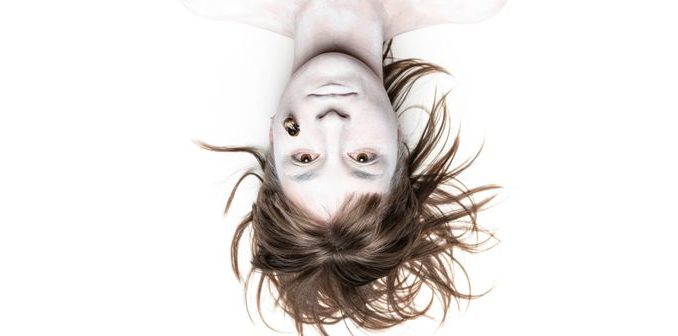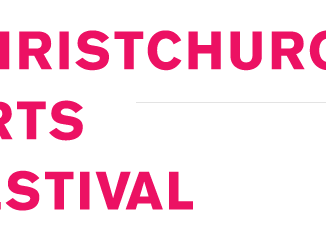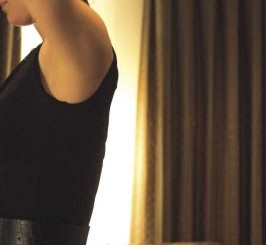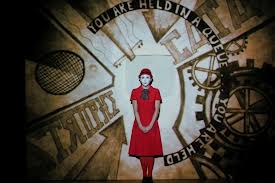
[A Swarm of Talent]
Running 6 to 21st September is a fascinating piece of dance-theatre. Set in the ruins of the pre-quake Court Theatre foyer, HIVE is a rare opportunity to explore one of Christchurch’s most significant cultural spaces while it’s under construction. Stepping into the makeshift set for HIVE is like stepping into a liminal space, where time doesn’t quite bend to real world rules.
This immersive work is also notable for the simple fact that audiences will be required to wear hardhats as a safety precaution. But, more importantly, longtime collaborators and co-creators Stuart Lloyd-Harris and Julia Harvie seek to challenge preconceptions of what dance-theatre looks and feels like. They are supported by dancers Josie Archer, Kosta Bogoievski, Sarah Elsworth, and cellist, Nicole Reddington.
Nathan Joe interviews the pair and talks existentialism, cults, authenticity and making work in post-quake city.
NATHAN JOE: How would you describe the show?
STUART LLOYD-HARRIS: In a single sentence, it’s a performance tour. It’s a tour with performance elements.
Outside of that, it’s a look at society with an existential bent, and that includes looking at elements of society where we’ve been drawing inspiration. From things that have made the news recently like Gloriavale and a bit of an investigation into other cults as well. Things like Jonestown and Heaven’s Gate and Waco. The idea that all of us are looking and searching for something. That’s a very existential kind of idea that we’re looking for meaning in an absurd world.
JULIA HARVIE: And I think also that there’s a question of… You know, you do watch all these documentaries and see all these perfectly intelligent, perfectly normal, people being drawn into the most bizarre situations and being prepared to do outrageous things and… What is it that leads you to end up in that situation? And what are the devices that these types of people use to manipulate other people?
SLH: The indoctrination into cults often is about mimicking social behaviours. We started looking at those things and looking at how we all exist in society in a way, when viewed from the outside, or from another society, it might look like we’re all kinda belonging to something where we’re not making choices. I mean, we’re sitting here, we’ve just bought coffee for six dollars and that seems perfectly normal to us. But it’s not, it’s ridiculous. There’s research to suggest that social media makes us unhappy and yet we all keep using it, consuming it, participating in that. Why? So, we thought we’d hold a mirror to society.
The show may draw from the ideas of people participating in religion, but in now way does it reference any religions specifically. It’s much more a case of saying…
JH: I think it’s ritual. There’s a lot of ritual elements to the work. And religion draws from ritual. That’s much more… that’s sort of far older than most modern religion. There’s a lot of that pagan stuff that gets pulled in our DNA. Those ritualistic things. Even in the ritual of what you do in the morning. Of how you start your day and things like that.
SLH: The word cult comes from cultus. People who cultivated a devotion. And that became seen as ultimately extremism. So the idea of a cult became an extreme idea of devotion to a deity or thing. Or an ideology. But the reality is, on a much more individual level, the idea of people searching for meaning in a world. I think all of us have that experience of “the world doesn’t make sense”. And you look at the news and you look at what’s happening overseas. Look at what’s happening in the States or the UK. It doesn’t make any sense. The world is absurd.
NJ: And why do you think dance is a good medium for these topics?
SLH: The show is really about creating experiences for the audience. More so than it is about putting performers on a stage. I think that’s where it differs from conventional, contemporary dance. It isn’t just about putting people on the stage for you to watch, but creating a series of experiences and leading people through those, and using dancers -- our performers -- to do that.
JH: We’re asking a lot more of our dancers than purely dancing as well.
NJ: Can you expand on that?
JH: I struggle with dancing. For me, it’s the body I’m more interested in, and also compositional choreography in a broader sense. And so, in a sense, choreography is about choreographing the audience without being explicit about that. Choreographing an experience, and also employing whatever is required to make the work. There is actually a lot of text that the performers incorporate.
NJ: Does the work speak to Christchurch in a post-quake context?
SLH: Living through the Christchurch quakes… Immediately in the aftermath, I think communities formed all over Christchurch and I think people were closer to each other. My experience personally is that you would talk to people in a line or a queue and you would stop and you would have conversations with people on the street. I met my neighbours for the first time, we would have conversations, we’d stand on the street. And this sense of community formed for a couple of years that felt like it’d always remain. It felt like Christchurch had changed. And I think people are tired and stressed… And I think that hasn’t been maintained and we’re going back to a much more insular existence. And I think there’s a… We are all being programmed to some extent. Social media programmes us to live in isolation and to consume and to participate in those forms of connection and not in immediate ones. This is not a work about social media but it’s something that massively informs and effects society.
JH: And I guess as artists, post-quake for us, for those of us making theatre works… I mean, I have made a couple of pieces for “the theatre” -- the pros[scenium] arch -- since the earthquakes. Not to say I wasn’t already interested in making work in other spaces, because I’ve been interested for ages in having different kinds of relationships with the audience. For me, this work speaks less so to being an artist in post-quake. I think we’re all affected by it. We can’t help it. In very practical ways trying to find spaces to make your work. To me, the work almost speaks to what it means to make work. Just like a cult leader or a politician or a corporation, you have to draw an audience in, you have to win them over, you have to market a product. You have to use whatever you can to connect with them. One tool that we’re interested in is making far less distinction between performers and the audience. Far less physical separation between the two.
This work is absolutely not about being impressed by virtuosic dancers. For me, that’s what ballet used to do for the emperor. It was propaganda. I feel like in this day and age with capitalism and the hunger for the product, dance has moved in that direction as well. It’s just about beautiful bodies and being good at dancing and very little consideration with other relationships you can build with the audience. For us, that audience relationship is totally metaphorical of the wider meaning of the word. Even the fact that they’re going to be cold, and they’re going to be aware of their physicality as well.
SLH: We made a work [Nobody Hears The Axe Fall] at the Fringe festival at the beginning of the year. And one of the reviewers described it as ‘ugly costumes’ and ‘ugly movement’ and the idea of ugly movement was kind of a compliment. Because what they were looking for was something balletic. And we didn’t give them that. All they wanted was to tick a box that said it’s balletic, it’s beautiful. And it wasn’t beautiful, and that’s what we were going for. So to get that as a comment from a reviewer was fantastic. And another reviewer said it was dark and suffocating, and that was great. That’s exactly the purpose of that other work. This one not so much. We’re not trying to suffocate people. This is much more to create an experience. With an understanding that we’re relying on the goodwill of the audience. This is not something we intend to abuse -- that goodwill -- or do anything that’s objectionable. You won’t be singled out.
JH: Yeah. Or say, I didn’t consent to this.
SLH: It’s really just a series of experiences and questions and interactions with the performers.
JH: Exchanges maybe.
SLH: But it’s certainly not ballet.
NJ: How does the work negotiate that contract between performer and audience?
SLH: We start out really interestingly with that because the first thing that every audience member has to do is put on a high-vis vest and be led onto a building site. So they already have to give us control. And so the idea that the audience signs over a certain kind of consent to us -- which is that we’re responsible for them -- is something that’s very unusual in a theatrical experience. Ordinarily you could walk into the theatre and there’d be the seats and the stage, very separate, and you’d have your space to belong. And, in this, the audience are really going to be welcomed into our space. And already have to give over a certain amount of control.
NJ: It’s like bungee jumping. Almost.
SLH: Yeah, you have to trust. But you put on the high-vis vest and you know someone is responsible for you. And you’re given a safety briefing which means don’t trip on something, don’t touch anything that’s sharp…
JH: And talk about virtuosity for us, there’s a virtuosity for the performers in being able to engage in a very natural and friendly way with the audience from the get go. It’s about them having to establish relationships. Something real, something authentic. That’s something we’ve really had to practice a lot. It’s not just about practicing the moves at all. They’ve got so many things they’re have to manage for themselves. And every audience is going to respond differently. And so they have to be quite agile. We can’t completely lock down certain aspects of the work. There has to be a degree of freedom, and they have to practice that freedom so that they can be responsive to what’s happening and not get floored if the audience does not comply, or to the way we speculated they may. These kinds of debates are had about how they’ll respond. We have to be able to manage whatever.
NJ: What keeps you making work in Christchurch?
JH: Yeah, making work in Christchurch… tough crowd.
SLH: It is a tough crowd, but actually there’s not so much competition in Christchurch for the avant-garde.
JH: That can go either way, though. If there’s not much of it happening, then people aren’t familiar and there’s not a scene around something. So you feel like you’re always building from scratch. Or you’re having to educate an audience from the get go. But I also think people have way more capacity than you realise for something. And that it always comes down to how you craft something as to whether you can win them over or not.
I mean, I live here. It’s almost like “Why do you keep making work?” is the question. And sometimes it’s just ‘cause I hang out with Stuart and we start talking. Inevitable.
NJ: What does the future of Christchurch arts look like for you? What do you hope for? Because, surely, to be making work in Christchurch is an act of hope.
JH: It is, yeah. I hope for openness. Open and willing. An audience that is excited by challenge. Is excited by work that is difficult to define. That issue that can come along… You make work for an audience that exists or you make work to create an audience. And I think we probably work in that second… We don’t go, “Oh there’s an audience for this sort of thing, so we’ll make that work.”
SLH: What we have to do is rely on our own experiences and go, “What would we enjoy enjoy? What would we get a kick out of or be challenged by?” And that has to be the stimulation which is just to pursue that. To constantly pursue something we think is of a quality or of an experience that is worthy of an audience. Because we all encounter performance that you can be immediately bored by. Something you’ve seen a hundred times. Something that is excessively conventional. I don’t get much out of that. There’s definitely an audience for conventional theatre. But it’s not me. So I’m always looking for something that’s a little bit of a challenge. I’d like to go away questioning something. Rather than with all the answers.
JH: We definitely want our work to produce questions.
The Hive plays Friday 6 to Saturday 21 September 2019
Times: One performance at 7.30pm on Tuesdays and Wednesdays and two performances at 5.30pm and 7.30pm on Thursdays, Fridays and Saturdays
Location: Meet at level one, Boys’ High building, The Arts Centre Te Matatiki Toi Ora, 26 Worcester Boulevard, Christchurch




Leave a Reply